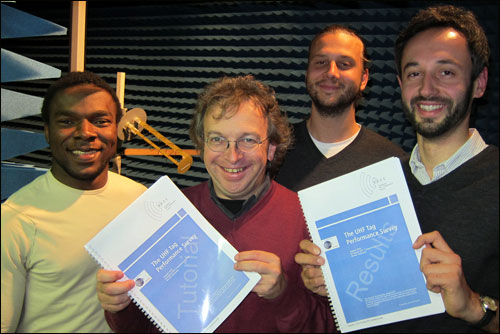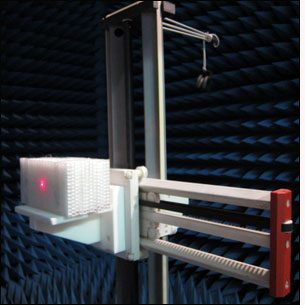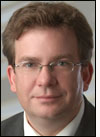A new report from the European EPC Competence Center (EECC) has found that the performance of ultrahigh-frequency (UHF) EPC Gen 2 tags has improved vastly from earlier technology. However, the study also notes that read rate (the percentage of tags successfully read) drops in bulk environments (in which many tags are packed within close proximity to each other), sometimes by as much as 85 percent. On the other hand, the report indicates, the better-performing tags experienced a reduction in read rate of only about 20 percent.
“The most surprising point was that the read range through the proximity effect (tags in bulk) sometimes increases up to 20 percent,” says Conrad von Bonin, EECC’s manager. In this case, it was the tags on the outer ends of the group that could be read at an increased distance from a reader. “It is not clear why,” von Bonin says. “In general, all tag types experience a decrease (in read range) in large populations.”
For the UHF Tag Performance Survey (UTPS) 2010 report, EECC researchers studied tags for both metal and non-metal environments, as well as two new chips: Impinj‘s Monza 4 and NXP Semiconductors‘ G2iL, both of which, according to the report, had a longer read range and a higher read rate than the companies’ prior offerings.
The EECC has completed UTPS studies annually since 2007. The first year, the center tested 20 EPC Gen 2 tag models (see European EPC Competence Center Releases UHF Tag Study), but the number of tag models tested this year—approximately 70—was twice the number examined in 2009, and included tags provided by Asian companies for the first time, as well as bulk-read (proximity) measurements.
Due to the increased use of RFID tags in high volume, such as by retailers with item- or carton-level tagging for merchandise, the group chose to conduct the study to determine how well UHF EPC Gen 2 tags operated in a crowded environment with many tags close to each other. This may be the first study to measure the effects of close proximity of EPC Gen 2 tag reads, von Bonin says, and it may be important to the retail market. For example, Wal-Mart Stores recently began working with its suppliers to attach tags on men’s jeans and undergarments (see Wal-Mart Relaunches EPC RFID Effort, Starting With Men’s Jeans and Basics), while in Germany, he adds, retailers such as Metro Group are planning to begin tagging crates of goods being shipped to stores.

According to the EECC’s latest report, there is a growing number of item-level applications in which tagged items are often packed very close to each other, resulting in a tag-to-tag distance of as little as 1 centimeter (0.4 inch). The study provides recommendations for the appropriate transponder types for particular applications, including bulk-reading environments for such items as CDs and DVDs, books, apparel and electronics.
The report is based on tests carried out by four researchers working 12 hours a day for five months at the EECC’s lab in Neuss, Germany. For proximity testing, the team placed 11 tags of the same make and model 1 centimeter apart on a honeycombed plastic brick measuring 12 centimeters by 24 centimeters (4.7 inches by 9.4 inches). Tests were conducted to simulate U.S., E.U. and Japanese regulatory conditions, taking into account the 866 MHz, 910 MHz, 922 MHz and 953 MHz UHF RF bands sanctioned, respectively, by the European Telecommunications Standards Institute (ETSI), the United States’ Federal Communications Commission (FCC) and Japan’s Association of Radio Industries and Businesses (ARIB). Measurements of each tag’s backscatter and read ranges were carried out at the three different RF bands approved by these organizations, with the reader set at power levels ranging from 15 dBm to 45 dBm. The measurements were taken with the tag positioned at various horizontal and vertical orientations. In the case of horizontal reads, the tags were mounted horizontally and rotated 360 degrees. To analyze the vertical plane, the tags were positioned vertically and turned 90 degrees, always 1 meter (3.3 feet) from the reader antenna. This amounted to more than 3,000 individual measurements for each tag.
The new generation of chips, the Monza 4 and G2iL, showed an increased sensitivity in bulk- or non-bulk (one tag at a time) reads by 15 to 20 percent, compared with the older versions, the Monza 3 and G2X. “So it is much easier to power those tags,” von Bonin says. The tags with the best read ranges, he notes, came from Alien Technology (made not with the Monza 4 or G2iL chip, but with Alien’s older Higgs 3 chip), UPM Raflatac, Avery Dennison and Invengo, while Asian tags provided a surprisingly good read range as well.
Beyond bulk-read testing, the tags were tested in free air, in an environment similar to what would be found if a tag were attached to a garment on a clothes hangar, as well as placed on a piece of Teflon 2 millimeters (0.02 inch) thick, to imitate paper-based items with a lot of air, such as diapers or toilet tissue; on a piece of Teflon 10 millimeters (0.4 inch) thick, to represent a beverage case; on a plastic bottle filled with distilled water, to mimic products such as salad dressing or milk; and on metal reflectors, to simulate metallic packaging, such as that used for coffee or chocolate.
Altogether, the researchers tested 30 tags of each make and model. Those with performance levels that deviated significantly from others of the same make and model were removed from the test, in order to enable the team to base its report on “average” tags. The reader equipment was built by the researchers using RFID hardware provided by National Instruments (NI).
When it comes to on-metal tags, the survey found that tags specifically designed for a metal environment are much smaller in size than they were even a year ago, while their overall read range has also increased dramatically. “That was surprising,” von Bonin says, adding that previous EECC studies found that most tags had one single frequency at which they were most effective (such as 910 MHz). “This was bad for the global market,” he notes, since such tags were likely to function well in one country or region, and not as well elsewhere. “In this year, this effect was reduced by some tags.” In addition, he says, there are simply many more tags available than in previous years, including a greater number of tags with a variety of form factors.
“This year,” von Bonin says, “there [were] much more tags available with a form that is not like a typical dipole (long and small),” but were instead round or square. This symmetric form, he indicates, resulted in a read range less likely to be affected by orientation. A dipole tag, for example, can have a 10-meter (33-foot) read range in one orientation, and nearly no read range at another orientation. “It would be much better,” he states, “to have 5-meter [16.4-foot] range out of all directions, to design a permanent good-working solution.” Currently, there are many tags available that provide that kind of uniform performance regardless of orientation.
The study also found that physically longer tags perform better than shorter tags and operate at a wider frequency range, so they can be used more easily in global applications. Very small tags, the researchers discovered, typically have a small read range. On the other hand, there are some tags with a medium form factor that perform very well.
The entire report—which consists of two sections (tutorial and results)—can be purchased via the EECC’s Web site as part of a subscription, for €395 ($529) per year with a five-year subscription. The single version costs €795 ($1,065).



